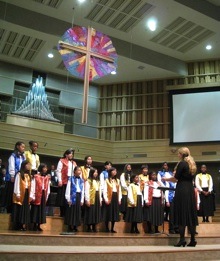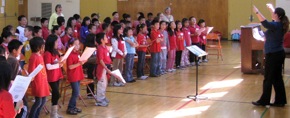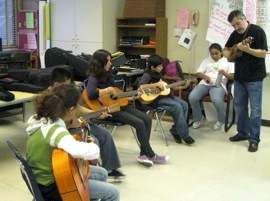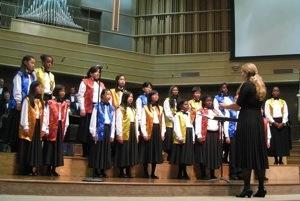Melanie DeMore was conducting a dozen young choristers in a downtown Oakland church the other day, getting them to move and groove and fire up the music.
“Make it funkier, greasier!” said the high-spirited, dreadlocked DeMore. The noted Bay Area singer, songwriter, and vocal conductor is an artist in residence with Cantare Con Vivo’s prized educational and outreach program, Cantare Children’s Choirs of Oakland. She was taking the advanced Nova choir through her I Can Do That, a popping, polyrhythmic ditty that had the kids slapping beats on their chests and laughing with delight.

Warmed up, the singers — a multiethnic group of middle and high school students — dug into the lovely Ghanaian gathering song Tue, Tue. They sang it in unison and then as a round. It’s one of the pieces the group will perform at Oakland’s First Baptist Church Friday night, when the Cantare children’s program, which now takes choral music to more than 1,000 inner-city, Oakland school kids every week, celebrates its 10th anniversary.
Each of the program’s four after-school choirs will perform individually. Then all 200 kids will join Cantare’s adult 100-voice symphonic choir for the premiere of Lee R. Kesselman’s oratorio Measuring the Holy, commissioned for the occasion and written with Cantare’s multicultural tradition in mind. Kesselman set the music to poetry written in Spanish, Chinese, Arabic, Greek, English, and even the Native American Wintu language.
“It really captures what we do,” said Julie Haydon, the director of the Children’s Choirs. She shaped the curriculum of the Cantare school programs, using the sequential system of music education inspired by the ideas of the Hungarian composer and educator Zoltán Kodály.
“My goal is for the kids to fall in love with music from all over the world, and to understand that there’s something beautiful and special about every style. Learning a folk song from Africa is just as important as learning a piece by Bach. Learning something in Hebrew is just as important as learning a tune like Blue Skies.”
Hooked on Music
The children’s program was started a decade ago by Cantare Con Vivo (meaning “Sing With Life”) founder David Morales, who wanted both to take choral music to urban neighborhoods where arts programs were few and far between, and to use music to create community. To draw kids in, he focused at first on pop and folk songs, like Marvin Gaye’s What’s Goin’ On?, This Land Is Your Land, and De Colores. Now the choirs sing everything from Bach’s Bist Du bei Mir to Irving Berlin’s Blue Skies.
Haydon, a flute-playing native of Lafayette with a music performance degree from Northwestern and a master’s in music education from Oakland’s Holy Names University, began volunteering with Cantare in 2001 and became the children’s program’s director two years later. She started going into schools like Lafayette Elementary in West Oakland, teaching songs and recruiting kids for the after-school choir.
“A lot of kids didn’t know what a choir was,” said Haydon, who now oversees eight teaching artists. They go into classrooms in a half-dozen Oakland schools and work with the after-school choirs. They teach kids to sing, read, and even write music, exploring everything from the music of the Andes to African-American musical traditions to the Native American songs and sea chanteys of the Gold Rush era. “Choral music had been cut out of most inner city schools,” she remarked. “But it’s such a natural way for people to start making music together. We wanted to reach more kids.”
One of them was Dayana Merino, who started singing in the Lafayette choir in the fifth grade. Now, five years later, she sings in the treble-voiced Nova choir.
“At first my mom had to drag me,” said Dayana, a lively 15-year-old with long black, wavy hair. She attends Encinal High in Alameda but lives in Oakland. “I didn’t really want to sing. I’d never sung before. But once I started, I just fell in love with music, and I couldn’t stop. It’s my passion.”

Dayana had just improvised a swinging little solo on Man in the Mirror, made famous by Michael Jackson, which is also on Friday’s bill. Haydon conducted the piece and asked DeMore for her input. “Spit out those words and make it rhythmically really emphatic,” DeMore told the kids. As for the “na-na-nas,” she added, “put some snap behind those bad boys!”
That clicked with Connie Tran, an eighth-grader at Westlake Middle School who got hooked on singing after joining the Cantare choir at Lincoln Elementary in Oakland’s Chinatown.
“I love to sing,” Tran said. “What would you do without music?”
Filling a Gap
Haydon wondered the same thing. She began teaching choral music at Lincoln in 2005, and it proved wildly successful with kids, parents, and teachers alike. Before Cantare came in, the school had a program to teach older kids how to play traditional Chinese instruments, but nothing for the younger ones.
“The teachers were thrilled,” Haydon said, “because they saw that while the kids were singing songs and having fun, they were also deriving the rhythms of those songs and finding the pitches — and suddenly they’re reading music.”
Haydon found her calling while working as a teaching artist for the Chicago Symphony, where she worked with children from elite symphony orchestras as well as from the projects. It was an innovative program that got kids into making music. “I knew that’s what I wanted to do with my life,” she said.

With the Kodály method, she went on, kids first learn to sing songs and play games. “They learn to love the song, and once they’re in love with it, they learn to take it apart. They learn to sing and write the rhythms. Then we learn about the pitches and intervals. The way most of us learned music — this is a whole note, this is a quarter note — you don’t feel it in your body. When you’ve sung and stepped to the beat and felt it, you become a more natural musician.”
Some of Haydon’s most gratifying experiences have come from teaching at Lincoln, where many of the students are English-language learners. Singing songs, having fun with the words, “has helped them develop those language skills,” she said.
Haydon had a particularly rewarding experience in 2006, when she brought together the predominantly Asian choristers from Lincoln and the African-American and Hispanic kids from Lafayette to sing at the church of a Cantare board member. She hadn’t anticipated that they might feel awkward with each other. It was touch-and-go at first, Haydon says, but as soon as they started singing, the kids saw they all knew the same tunes, “and the barriers broke down. They became one group.”
The nonprofit Cantare con Vivo spends about $200,000 a year on its children’s choir and educational program. The money comes from government and foundation grants as well as individual donors. The kids pay nothing. The organization provides the uniforms, transportation to rehearsals and concerts when needed, and food on the field trips.
“The thing about Cantare that’s so special, that drew me in, is that it teaches music in a way that changes people’s lives,” Haydon said. “When you perform music at a very high quality and show the discipline that’s needed to make it beautiful, it changes you. Then you want to do more and learn more, and you feel connected to the people you made music with. And little by little, your small community changes. And as we combine choirs from different schools, we become one large community. And little by little, the whole community changes. It sounds like a cliché, but it’s true.”

